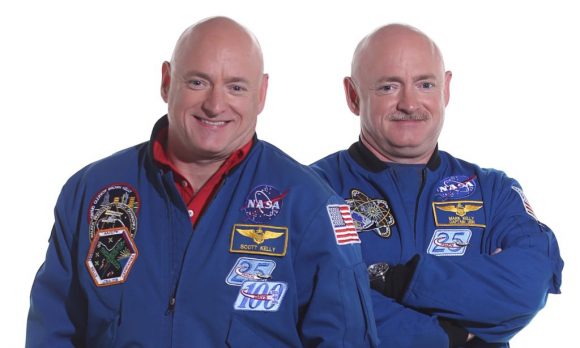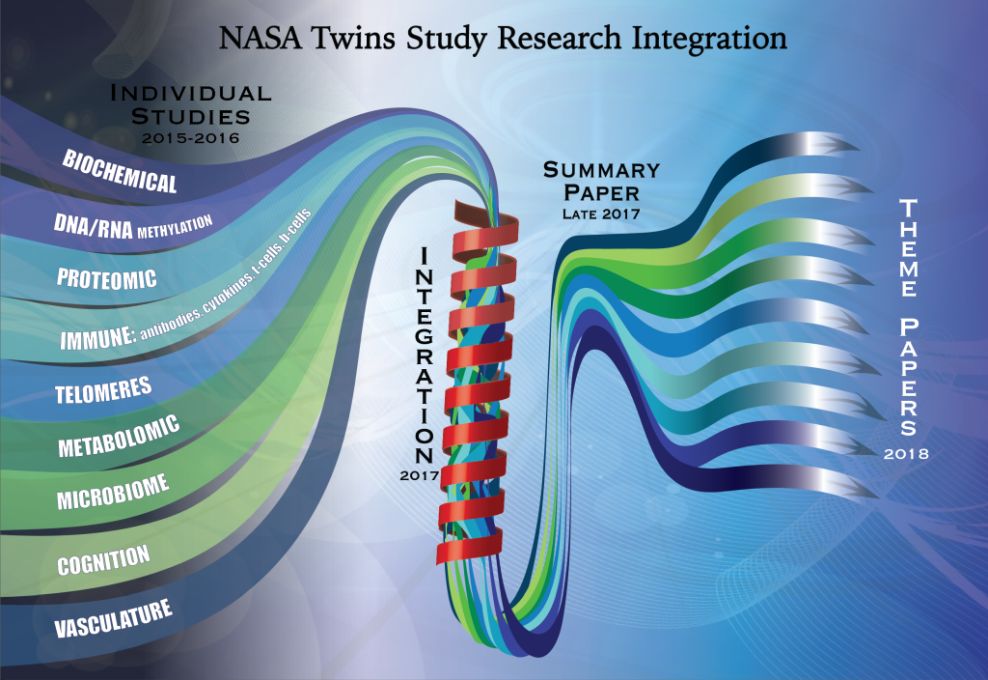People who plan and conduct space missions never tire of telling us how hard it is to do things in space.
Our next big goal is getting humans to Mars, and establishing a colony there. There are a multitude of technical and engineering hurdles to be overcome, but we think we can do it.
But the other side of the coin is the physiological hurdles to be overcome. Those may prove to be much more challenging to deal with. NASA’s twins study is poised to add an enormous amount of data to our growing body of knowledge on the effects of space travel on human beings.

Astronaut twins Scott and Mark Kelly are the basis of NASA’s study. Scott spent a year in space, returning to Earth on March 1st 2016, after spending 340 days aboard the ISS. Mark, himself a retired astronaut, remained on Earth during Scott’s year in space, providing a baseline for studying the effects on the human body of such a prolonged period of time away from Earth.
In February of 2016, NASA released preliminary results of the study. Now, the team studying the results of the twins study has started integrating the data. The way they’re doing this sets it apart from other studies.
“No one has ever looked this deeply at a human subject and profiled them in this detail.” – Tejaswini Mishra, Ph.D., Stanford University School of Medicine.
Typically, individual studies are released to appropriate journals more or less one at a time. But in the twins study, the data will be integrated and summarized before individual papers are published on separate themes. The idea is that taken together, their impact on our understanding of prolonged time in space will be much greater.
“The beauty of this study is when integrating rich data sets of physiological, neurobehavioral and molecular information, one can draw correlations and see patterns,” said Tejaswini Mishra, Ph.D., research fellow at Stanford University School of Medicine, who is creating the integrated database, recording results and looking for correlations. “No one has ever looked this deeply at a human subject and profiled them in this detail. Most researchers combine maybe two to three types of data but this study is one of the few that is collecting many different types of data and an unprecedented amount of information.”
“Each investigation within the study complements the other.” – Brinda Rana, Ph.D., U of C, San Diego School of Medicine
Mike Snyder, Ph.D, is the head of a team of people at Stanford that will work to synthesize the data. There are roughly three steps in the overall process:
- Individual researchers in areas like cognition, biochemistry, and immunology will analyze and compile their data then share their results with the Stanford team.
- The Stanford team will then further integrate those results into larger data sets.
- Those larger data sets will then be reviewed and analyzed to confirm and modify the initial findings.
“There are a lot of firsts with this study and that makes it exciting,” said Brinda Rana, Ph.D., associate professor of psychiatry, University of California San Diego School of Medicine. “A comparative study with one twin in space and one on Earth has never been done before. Each investigation within the study complements the other.”
NASA compares the twins study, and the new integrated method of handling all the results, to conducting a symphony. Each study is like an instrument, and instead of each one playing a solo, they will be added into a greater whole. The team at Stanford is like the conductor. If you’ve ever listened to an orchestra, you know how powerful that can be.
“The human systems in the body are all intertwined which is why we should view the data in a holistic way,” said Scott M. Smith, Ph.D., NASA manager for nutritional biochemistry at the Johnson Space Center. He conducts biochemical profiles on astronauts and his research is targeted to specific metabolites, end products of various biological pathways and processes.
“It is a more comprehensive way to conduct research.” – Chris Mason, Ph.D., associate professor, Department of Physiology and Biophysics Weill Cornell Medicine
Chris Mason Ph.D., at Weill Cornell Medicine said, “Both the universe and the human body are complicated systems and we are studying something hard to see. It’s like having a new flashlight that illuminates the previously dark gears of molecular interactions. It is a more comprehensive way to conduct research.”
Scientists involved with the twins study are very clearly excited about this new approach. Having twin astronauts is an extraordinary opportunity, and will advance our understanding of spaceflight on human physiology enormously.
“There is no doubt, the learnings from integrating our data will be priceless,” said Emmanuel Mignot, M.D., Ph.D., director of Center for Sleep Science and Medicine, Stanford University School of Medicine. He studies the immune system and is enthusiastic to study specific immune cell populations because many of the other immune studies focus only on general factors.
A summary of the early results should be out by early 2018, or possible late 2017. Individual papers on more detailed themes will follow shortly.


Man on Mars in the 2030s? Never, ever happen. These people are totally delusional. It will be more like the 2130s, is there is any human civilization left.